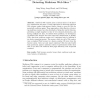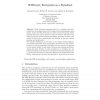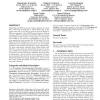38 search results - page 2 / 8 » Protection and communication abstractions for web browsers i... |
COLCOM
2008
IEEE
13 years 7 months ago
2008
IEEE
Abstract. Malicious Web content poses a serious threat to the Internet, organizations and users. Current approaches to detecting malicious Web content employ high-powered honey cli...
USS
2008
13 years 8 months ago
2008
Many web sites embed third-party content in frames, relying on the browser's security policy to protect them from malicious content. Frames, however, are often insufficient i...
ACNS
2006
Springer
13 years 11 months ago
2006
Springer
Abstract. While web-based communications (e.g., webmail or web chatrooms) are increasingly protected by transport-layer cryptographic mechanisms, such as the SSL/TLS protocol, ther...
ICWS
2009
IEEE
13 years 3 months ago
2009
IEEE
Traditionally, the composition of Web services to create mashups has been achieved by using an application server as a mediator between a client browser and services. To avoid thi...
CCS
2008
ACM
13 years 7 months ago
2008
ACM
Single-Sign-On (SSO) protocols enable companies to establish a federated environment in which clients sign in the system once and yet are able to access to services offered by dif...



